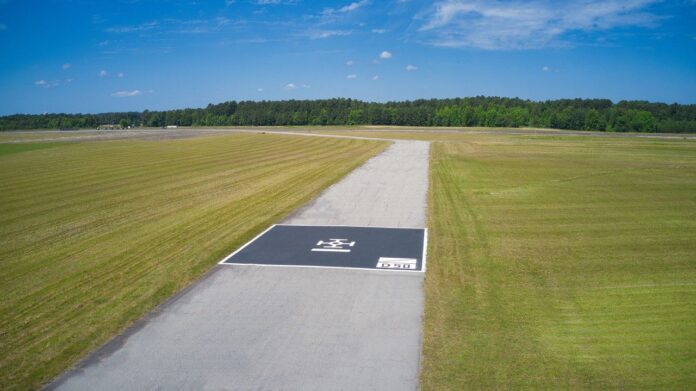Virginia Tech research is helping launch the future of air transportation in the Commonwealth of Virginia.
Launched in March, the Virginia Advanced Air Mobility Smart Airspace Program is a university-led initiative to research and develop low level routing and instrument flight procedures for the departure and arrival of advanced air mobility (AAM) aircraft. This includes the use of vertiports, ultra short access points, and other community-friendly AAM infrastructure.
Funded by the Virginia Department of Aviation and the Virginia Small Aircraft Transportation Systems Lab, the procedures developed will comply with Federal Aviation Administration (FAA) rules already in place while accounting for the unique capabilities of advanced air mobility aircraft with the goal of creating the first FAA-approved flight operations network of its kind in the United States.
“This project holds great promise for connecting Blacksburg and the New River Valley to the Roanoke metro and other regions of Virginia that have previously not been affordable or made possible,” said Greg Campbell, director of the Virginia Department of Aviation and president of Virginia Small Aircraft Transportation Systems Lab. “AAM envisions technologies, such as lower-cost air taxi and cargo operations utilizing new aircraft platforms, and propulsion systems to connect regions of the commonwealth. The Smart Airspace Program represents an important step in the Virginia Strategy for Advanced Air Mobility in the commonwealth, and positions Virginia to lead in the integration of these new aviation transportation technologies.”
Part of Virginia’s Advanced Air Mobility Strategic Plan, the project will be led by the Virginia Tech Mid-Atlantic Aviation Partnership (MAAP), an FAA-designated uncrewed aircraft systems (UAS) test site, and include significant collaboration with NAVOS Air, an FAA-authorized developer of instrument flight procedures.
The unique capabilities of these aircraft allow for the use of nontraditional aviation infrastructure, such as vertiports and ultra short access points. Vertiports are a special type of airport designed to support the vertical takeoffs and landings of autonomous aircraft and can include advanced ground infrastructure, such as electric charging stations. Ultra short access points allow for fixed-wing aircraft takeoffs and landings in as little as 150 feet.
The project will focus on the use of electric and hybrid-electric aircraft, flown autonomously or with pilots, for both passenger and cargo operations. These aircraft will be capable of taking off and landing in very small spaces at community friendly access points. The Virginia Advanced Air Mobility Smart Airspace Program network created will include:
- Establishing an off-airport vertiport at the Virginia Tech Transportation Institute in Blacksburg
- Establishing an on-airport vertiport at the Roanoke-Blacksburg Airport in Roanoke
- Connecting the new vertiports with existing FAA-approved vertiport and infrastructure at the Allen C. Perkinson Airport in Blackstone
- Integrating ultra short access points into the existing AAM infrastructure
Research conducted at the Roanoke-Blacksburg Airport will be thoroughly vetted and coordinated with airport authorities while strictly adhering to established safety rules and protocols.
Including on- and off-airport vertiports will allow for the research to support AAM infrastructure placement in a wide range of locations across Virginia.
MAAP Director Tombo Jones recently presented the plan to the Governor’s Aerospace Advisory Council, of which he is a member.
“With this project, we’ll add an on-airport vertiport in a terminal airspace, which describes the airspace around an airport with a control tower, as well as one at an off-airport site, and the associated instrument procedures to accompany both vertiports” Jones said. “So it’s really both ends of the spectrum in terms of the environments for vertiports and the types of air traffic to navigate.”
Currently, the airport in Blackstone is home to the only FAA-approved and state-licensed vertiport. It resulted from the work of MAAP and NAVOS Air and provided a basis of proven research and process that will be leveraged in this project.
Virginia Advanced Air Mobility Smart Airspace Program research will play a leading role in fostering a future safe AAM ecosystem. Additionally, each newly established vertiport will feature planned instrument flight rules for arrivals and departures.
Instrument flight rules refer to the regulations and procedures for pilots relying on flight instruments, rather than vision, for navigation and guidance while providing air traffic controllers a clear understanding of flight paths. Traffic management with instrument flight rules helps maintain aircraft separation, quickly identifies flight disruptions, and provides critical traffic deconfliction, an element that will be necessary for safe, ubiquitous AAM flights.
“By knowing exactly where the aircraft are going to fly on their route, they can tell the aircraft to slow down, speed up, or make other changes to ensure safety,” Jones said. “It’s very controlled, like a highway for aircraft where the controllers can provide spacing and sequencing to ensure safety.”
Jones said traditional approach and departure procedures have very long ascents and descents, sometimes up to 10 miles, with a very gradual change in altitude to reduce pilot workload and to deliver the aircraft over the runway in a very stable manner. Increasingly advanced and autonomous aircraft, however, substantially reduce or eliminate pilot workload and are more maneuverable, which can allow them to take a different path, saving energy and preserving their in-flight range.
“Most of the fully electric aircraft being built today only have an expected range of about 100 miles, so if they use traditional procedures, they are eating up a good chunk of their range and consuming some of their limited reserves,” Jones said.
By utilizing existing regulatory-compliant instrument approach and departure procedures to scale instrument flight rules of operations for AAM aircraft, the Virginia Advanced Air Mobility Smart Airspace Program will establish the first civil flight operations network of its kind in the U.S.
“AAM specific instrument flight procedures will be a critical enabler for AAM economic viability,” said Matt Burton, technical director at NAVOS Air. “It is impossible to imagine a sustainable air transport industry that does not operate in challenging weather conditions, such as clouds and rain, as part of the air traffic control instrument flight rules environment. The Smart Airspace Program will create this infrastructure to safely study optimizing existing instrument procedures for AAM operations. By accommodating the flight profiles and energy demands of AAM aircraft, we can enable integration with current national airspace operations while providing research needed to inform air traffic management systems of the future.”
This initiative will leverage the ongoing work of Virginia Tech and MAAP to research emerging autonomous aircraft to increase both safety and efficiency.
Jones said MAAP being selected to lead the project was partially the result of the ongoing collaboration with Virginia Tech’s Innovation and Partnerships team, specifically LINK: Center for Advancing Partnerships, which supports relationships with a range of companies and foundations. Through holistic engagement strategies and careful stewardship, LINK is well positioned to pick up demand signals from industry grappling with technical, talent, policy, and market challenges and help connect these with Virginia Tech’s assets and expertise.
“Partnering with industry leaders at the forefront of technological innovation allows Virginia Tech to stay ahead of emerging needs and co-develop cutting-edge solutions,” said Brandy Salmon, associate vice president for innovation and partnerships at Virginia Tech. “By bringing an outside-in perspective, we can anticipate where technology is headed and strategically leverage our talent, infrastructure, and service-driven approach to advance bold ideas that fuel industry growth and amplify Virginia Tech’s impact. This particular effort leverages the tremendous potential of MAAP as well as a constellation of other assets at Virginia Tech to build a truly unique platform.”
Jones said the Virginia Advanced Air Mobility Smart Airspace Program is a great example of the transformational impact that can be created when stakeholders come together to advance an important area of science and technology. This program not only has the potential to play a critical role in the future of Virginia’s airspace, it offers a path toward cementing the commonwealth as a national leader in the future of flight.
“With this project the state is continuing its commitment to position Virginia as a leader in Advanced Air Mobility,” Jones said. “We just really appreciate the opportunity to help shape that future.”
By Travis Williams


